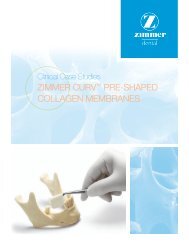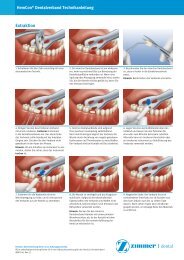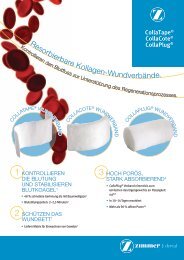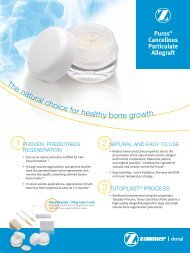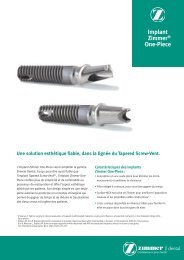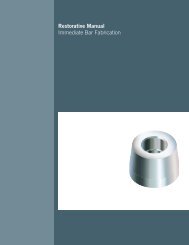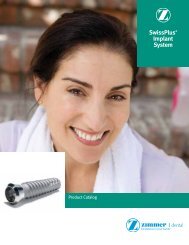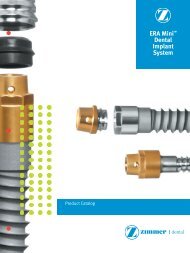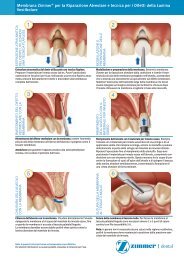CE 1Figure 7E—Closure <strong>and</strong> left lateral centric occlusion view.Figure 7F—Case complete clinical view of the immediaterestored implants placed in conjunction with sinus elevationsurgery at 5½ months.Figure 7G—Case complete periapical radiograph.implant carriers, the preprepared HLA stockabutments are seated, <strong>and</strong> the provisionalrestoration is inserted to confirm implant placement,before retrofitting with a composite material(Figure 7D). After the conversion of the surgicalguide to the provisional restoration, cementationof the restoration is achieved with a strongtemporary cement. Application of PRP over thelateral aspect of the maxillae precedes additionalgrafting with the PRP/PepGen graft complex atthe osteotomy site in the lateral wall of the maxillae,<strong>and</strong> the peri-implant defect sites. Closureis accomplished with 4.0 Vicryl Rapide sutures(Figure 7E). Note that in centric occlusion,disclusion is present from Nos. 13 to 15. In thenormal chewing cycle, small amounts of loadwill undoubtedly be present, <strong>and</strong> the authorobserves that enhancement of the maturationphase of the graft occurs, based on earlierdefinitive load times.After careful observation for 4½ months, thepatient is referred for completion of implantprosthetics. The final implant-supported restorations(Figure 7F) are seated 5½ months after theinitial, <strong>and</strong> only, surgical procedure. The casecomplete periapical radiograph shows the sinusgraft well incorporated at the level of theimplants (Figure 7G).Conclusion<strong>Implant</strong> treatment has previously beenseparated into the surgical <strong>and</strong> restorativephases. Depending on the complexity of theplanned site, the surgical phase may requiretwo to four procedures in conventionalimplant treatment. The restorative phase,especially in the esthetic zone, may requiretissue sculpting <strong>and</strong> provisionalization toachieve the foundation not only for esthetics,but also for long-term restorative success. Overthe years, conventional implant treatment hasproven to be a highly successful treatmentoption for replacing the natural tooth system.Advancements in surgical techniques,bone grafting materials, <strong>and</strong> bioengineering ofthe surgical site, have allowed the implantsurgeon to decrease treatment times <strong>and</strong> possiblysurgical visits. However, without propercommunication among the surgeon, restorativedentist, <strong>and</strong> laboratory technician, poor orimproper treatment planning leads to complex,<strong>and</strong>/or compromised prosthetic procedures.Continued advancements in surgical stentdesigns <strong>and</strong> the incorporation of provisionalrestorations during implant placement haveallowed the implant team (ie, surgeon, reconstructivedentist, <strong>and</strong> laboratory technician) tobetter communicate the parameters for thefunctional, biological, <strong>and</strong> esthetic success inimplant restorations.The immediate restoration of dentalimplants is an exciting option the implantteam can offer patients seeking implant treatment.The incorporation of a provisionalrestoration during implant placement providesthe patient with a stable, esthetic temporaryrestoration. From a periodontal perspective,the author observes that the preservation of10 Compendium / February 2003 Vol. 24, No. 2
interdental bone, creation or maintenance of thesoft tissue, <strong>and</strong> formation of a sound biologicwidth environment are all benefits of immediaterestoration—in addition to decreasing patienttreatment time. The author recommends continuedresearch <strong>and</strong> clinical studies on this procedureto supplement initial clinical reports presentedin recent literature.DisclosureThe author of this article works asa consultant for Centerpulse, DentsplyFriadent CeraMed, <strong>and</strong> Harvest TechnologiesCorporation.References1. Wohrle PS. Single-tooth replacement in the aesthetic zonewith immediate provisionalization: fourteen consecutive casereports. Pract Periodontics Aesthet Dent. 1998;10:1107-1114.2. Salama H, Salama MA, Garber D, et al. The interproximalheight of bone: the guidepost to predictable aesthetic strategies<strong>and</strong> soft tissue contours in anterior tooth replacement.Pract Periodontics Aesthet Dent. 1998;10:1131-1141.3. Saadoun AP, Le Gall MG. Periodontal implications inimplant treatment planning for aesthetic results. PractPeriodontics Aesthet Dent. 1998;10:655-664.4. Kois JC. Altering gingival levels: the restorative connections.Part 1: biological variables. J Esthet Dent. 1994;6:3-9.5. Tarnow DP, Magne AW, Fletcher P. The effect from the distancefrom the contact point to the crest of one on the presenceor absence of interproximal dental papillae.J Periodontol. 1992;63:995-996.6. Tarnow DP, Cho SC, Wallace SS. The effect of inter-implantdistance on the height of the inter-implant bone crest.J Periodontol. 2000;71:546-549.7. Salama H, Salama M. The role of orthodontic extrusiveremodeling in the enhancement of soft <strong>and</strong> hard tissueprofiles prior to implant placement: a systematic approachto the management of extraction site defects. IntJ Periodontics Restorative Dent. 1993;13:312-333.8. Kan JY, Rungcharassaeng K. <strong>Immediate</strong> placement <strong>and</strong>provisionalization of maxillary anterior single implants: asurgical <strong>and</strong> prosthetic rationale. Pract Periodontics AesthetDent. 2000;12:817-824.9. Saadoun AP. <strong>Immediate</strong> implant placement <strong>and</strong> temporizationin extraction <strong>and</strong> healing sites. Compend ContinEduc Dent. 2002;23:309-323.10. Marx RE, Carlson ER, Eichstaedt RM, et al. Platelet richplasma. Growth factor enhancement for bone grafts. OralSurg Oral Med Oral Pathol Radiol Endod. 1998;85:638-646.11. Lynch SE, Genco RJ, Marx RE, (eds). Tissue Engineering:Applications in Maxillofacial Surgery <strong>and</strong> Periodontics. CarolStream, IL: Quintessence Publishing Co, 71-77, 1999.12. Petrungaro PS. <strong>Immediate</strong> restoration of dental implantsafter tooth removal: A new technique to provide estheticreplacement of the natural tooth system. InternationalMagazine of Oral <strong>Implant</strong>ol. 2001;2:6-16.13. Petrungaro PS. <strong>Immediate</strong> restoration of multiple toothimplants for aesthetic implant restorations. <strong>Implant</strong> Dent.2002;11:118-126.14. Petrungaro PS, Maragos C, Matheson O. Using the MasterDiagnostic Model ® to enhance restorative success inimplant treatment. Compend Contin Educ Dent.2000;21:33-42.15. Petrungaro PS. Using the TempStent technique to simplifysurgical stent <strong>and</strong> esthetic temporary fabrication in immediatelyrestored implants in the esthetic zone. ContemporaryEsthetics <strong>and</strong> Restorative Practice. 2002;6(5):84-90.16. Jensen J, Sindet-Pedersen S. Autogenous m<strong>and</strong>ibular bonegrafts <strong>and</strong> osseointegrated implants for reconstruction of theseverely atrophied maxilla: a preliminary report. J OralMaxillofac Surg. 1991;49:1277-1287.17. Misch CM, Misch CE, Resnik RR, et al. Reconstruction ofmaxillary alveolar defects with m<strong>and</strong>ibular symphysis graftsfor dental implants: a preliminary procedural report. Int JOral Maxillofac <strong>Implant</strong>s. 1992;7:360-366.18. Jensen J, Sinder-Pedersen S, Oliver AJ. Varying treatmentstrategies for reconstruction of maxillary atrophy withimplants: results in 98 patients. J Oral Maxillofac Surg.1994;52:210-216.19. Misch CM, Misch CE. The repair of localized severe ridgedefects for implant placement using m<strong>and</strong>ibular bone grafts.<strong>Implant</strong> Dent. 1995;4:261-267.20. Krauser JT, Rohrer MD, Wallace SS. Human histologic <strong>and</strong>histomorphometric analysis comparing OsteoGraf/N withPep-Gen P-15 in the maxillary sinus elevation procedure: Acase report. <strong>Implant</strong> Dent. 2000;9:298-302.21. Smiler DG. Comparison of anorganic bovine material with<strong>and</strong> without synthetic peptide in a sinus elevation: A casestudy. <strong>Implant</strong> Dent. 2001;10(2)139-142.22. Mellonig JT, Bowers GM, Bailey RC. Comparison of bonegraft materials Part 1. New bone formation with autografts<strong>and</strong> allografts determined by Strontium–85. J Periodontol.1981;52:291-296.23. Jarcho M. Calcium phosphates as hard tissue prosthetics. ClinOrthop. 1981;157:259-278.24. Froum SJ. Human histologic evaluation of HTR polymer<strong>and</strong> freeze-dried bone allograft. J Clin Periodontol.1996;23:615-620.25. Shapoff CA, Alex<strong>and</strong>er DC, Clark AE. Clinical use of bioactiveglass particulate in the treatment of human osseousdefects. Compend Contin Educ Dent. 1997;18:352-358.26. Sottasanti JS. Calcium sulfate: a biodegradable <strong>and</strong> biocompatiblebarrier for guided tissue regeneration. CompendContin Educ Dent. 1992;13:226-234.27. Sottasanti JS. Aesthetic extractions with calcium sulfate <strong>and</strong>the principles of guided tissue regeneration. Pract PeriodonticsAesthet Dent. 1993;5:61-69.28. Urist MR, Strates BS. Bone morphogenic protein. J Dent Res.1971;50:1392-1406.29. Urist MR, Silverman BF, Buring K, et al. The bone inductionprinciple. Clin Orthop. 1967;53:243-283.30. Burwell RG. The function of bone marrow in the incorporationof a bone graft. Clin Orthop. 1985;200:125-141.31. Callan DP, Rohrer MD. Use of bovine-derived hydroxylapatitein the treatment of edentulous ridge defects: ahuman clinical <strong>and</strong> histologic case report. J Periodontol.1993;64:575-582.32. Petrungaro PS. Platelet-rich plasma for dental implants <strong>and</strong>soft-tissue grafting. Dent <strong>Implant</strong>ol Update. 2001;12:41-46.33. Petrungaro PS. Using platelet-rich plasma to accelerate softtissue maturation in esthetic periodontal surgery. CompendContin Educ Dent. 2001;22:729-746.34. Petrungaro PS. <strong>Immediate</strong> restoration of dental implants inthe aesthetic zone. Dent <strong>Implant</strong>ol Update. 2001;12:89-95.35. Marx RE, Garg AK. Bone graft physiology with use of PRP<strong>and</strong> hyperbaric oxygen. In: Jensen OT. The Sinus Bone Grafts,Chicago, IL, Quintessence Publishing Co, 1999.36. Anitua E. Plasma rich in growth factors: preliminary resultsof use in the preparation of future sites for implants. Int J OralMaxillofac <strong>Implant</strong>s. 1999;14:529-535.CE 1Vol. 24, No. 2 Compendium / February 200311



